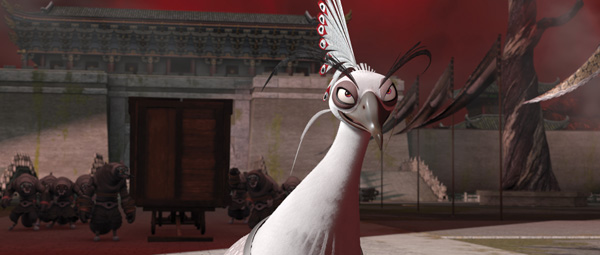
Head of lighting and digital effects supervisor at DreamWorks, Dave Walvoord came to ‘Kung Fu Panda 2’ having worked on the first Kung Fu Panda movie. Although the lighting team had done much of the groundwork on that first production, they weren’t necessarily trying to re-invent those looks on the new film.
 |
|
|
| The first time around, they defined the physics and rules for light behaviour within the movie’s universe. “For this project, we wanted to keep that set of rules but follow them much more consistently, push deeper into this world and explore it and flesh it out. We could also take advantage of new software developments at DreamWorks to add to it,” he said.
Light Behaviour This was Dave’s and his team’s first stereo film. All of them were very comfortable and skilled in the 2D realm but as soon as they began working and experimenting with stereo, they found many techniques they had previously relied on were suddenly not going to work. So they actually went back and chose two sequences in ‘Kung Fu Panda 1’, converted them to stereo and completely re-rendered them to see what their world would look like in the new medium – before starting to plan their second film. “This exercise made us realize that relying heavily on very shallow focus, as we had done earlier, wasn’t as viable here. We had used it to direct viewers’ attention to a specific spot in the frame. This world is very ornate with rich textures. It’s one of the film’s trademarks but it’s easy for viewers’ eyes to wander across the frame,” he said. New Tricks “It became a learning and adaption experience. We still maintained our regular CG pipeline – storyboards, layout and camera, animation followed by lighting, which means the camera and lighting were somewhat separated. We continued to focus on shaping the lighting in each frame, but kept the staging in mind.” The production designer, VFX supervisor and head of layout planned the entire movie between them, while Dave’s team interacted mostly with the surfacing department, who in turn interact with the modellers, and work with them on textures and fur. Dave’s relationship with the head of surfacing was very direct. Together they fleshed out the assets in pre-production and exchanged revisions to improve looks. They also aimed to make all surfaces easy to light. Fur Shader The team met the challenge, but Dave explained that people know intuitively how light should behave. This is why highly stylised looks are hard to push convincingly. Vision is our primary sense, and we are hard to fool. It can be fun to experiment but the result has to be believable – otherwise the entire story about Kung Fu fighting animals falls apart. Breaking Rules He maintains a strict regard for physics. “Even for those extreme looks, the goal is to cheat physics as little as possible and base a lighting design on reality. When lighting elements like water, metal or diamonds, for example, our job isn’t lighting the object but the environment around it and then revealing what that object ‘sees’ – it will reflect and refract the light in this environment.” Dave’s team do all of their work with DreamWorks’ proprietary tools. What he finds the most beneficial about this software is that, across the company, all the tools are made to work together. “Commercial packages are made specifically for modelling, or animation, or lighting. They are also made for a single artist working in isolation. The software here fits the different applications together and is massively scalable so that teams of hundreds of artists can work together. New Generation The movie’s final battle sequence brought some special considerations because it brings together all characters, crowds, water, the complete city, even the peacock – all together, fighting it out. That was the technical side of it. Creatively, it was especially difficult because the lighting was very dark and it was essentially a two-colour scene, red and blue for fire versus water. “Because objects were losing their local colour, they were hard for the audience to identify. Including so much action with these factors meant we had to ensure that the audience always looked where we wanted them to. We had to remain aware of the dramatic intention and not disturb the flow,” said Dave. A Lighting Life Dave has now been working nine years at DreamWorks, staring as a pipeline technician with lighting as his strong point. “When CG filmmaking really began to take hold, I was still at Blue Sky and I helped work out how to actually make a movie in the medium. I was working on a pipeline for it, which is how DreamWorks became interested in me. Eventually, though, I felt that this kind of work was pulling me away from creating images, which is what interested me in animation in the beginning. So I came back to it through lighting. I believe lighting can enhance stories and emotions in films as much as music does.” |
| Words: Adriene Hurst Images: Courtesy of DreamWorks Animation |
| MORE FEATURE ARTICLESFeatured in Digital Media World. Subscribe to the print edition of the magazine and receive the full story with all the images delivered to you. Only $79 per year. PDF version only FREEsubscribe |
|
|
























